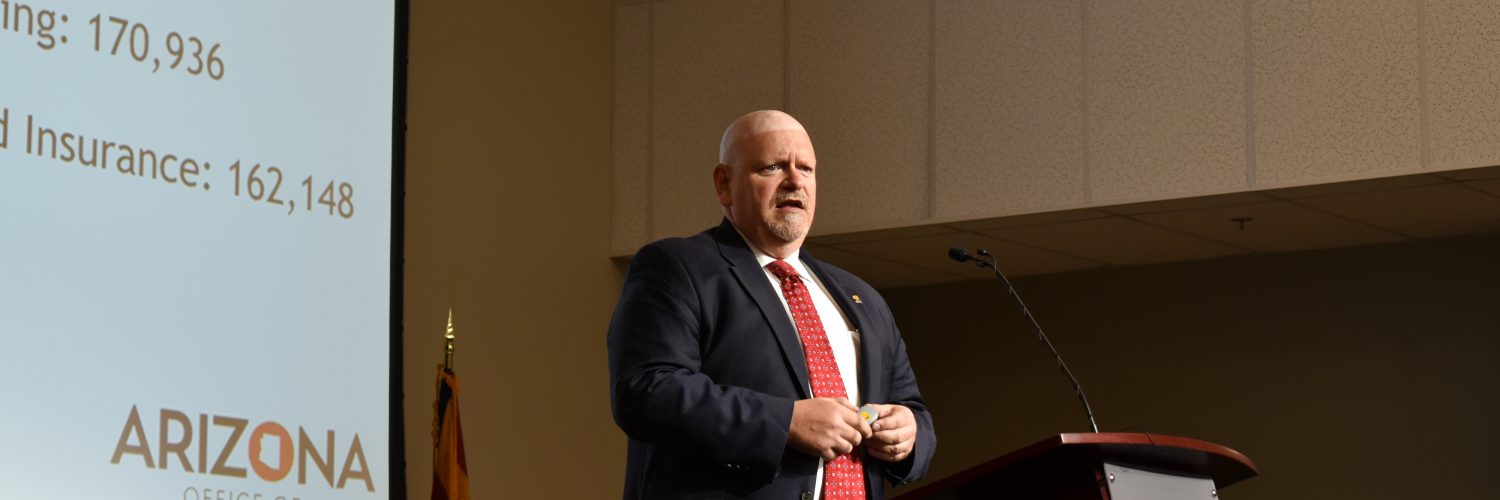Southern Arizona business leaders gathered last week at the University of Arizona Tech Park in Tucson to attend the Aerospace and Defense Workforce Innovation Summit, hosted by the Tucson Metro Chamber, and share innovative new ways to connect students with career opportunities.
“Our labor market is very diverse across Arizona,” said Trevor Stokes, workforce program manager for the Arizona Office of Economic Opportunity. “Approximately seven percent of all of our jobs are in manufacturing of some kind. Manufacturing growth across our economy, over the last two years in particular, has been striking.”
Currently, the manufacturing sector’s impact on the state economy is equal to that of the construction, transportation, utilities, mining and agriculture sectors, combined, Stokes said. Data shows more than 12,500 jobs have been added to the sector in the past two years, he said.
But job growth can come with challenges. The Office of Economic Opportunity projects more than 19,000 new jobs will be added in the manufacturing sector between 2016 and 2026.
“As a workforce practitioner, that is the kind of information that keeps me up at night,” Stokes said. “Where do I find 20,000 people with an appropriate skills profile to enter our workforce and support our manufacturing community? Are these skills being developed in our high school programs, our community college programs? How are we actually developing the skills that will actualize success in this super, highly-critical sector across our state?”
The key to growing the emerging labor supply in those critical industries lies in career literacy. Students need to know what their options are early on, or they will not be prepared to take advantage of the opportunities available to them when they are presented.
“We have to be able to communicate the value proposition of our sector to our emerging labor supply before they start making their decisions about what they’re going to do with life after high school,” Stokes said. “Career literacy is the key to enhancing the talent pipeline for our industry, and career literacy efforts have to begin in middle school.”
Stokes said he visited a classroom a couple months ago — something he does often — to give a presentation about opportunities in the construction industry.
Before he left the school, Stokes received an email from the teacher saying, “I have never seen my kids more excited about their education than they are right now. They are lined up at my desk to make counseling appointments,” he recalled.
“Why did that resonate with these students? I think it was because we showed them there is a chance to get into real-world career opportunities that are valuable, that you want, that will afford you the lifestyle that you want,” Stokes explained.
There was something unique about that group of students, though: the class was at Adobe Mountain High School in Phoenix, which is run by the Department of Juvenile Corrections. The entire classroom was incarcerated 18-year-old young men, Stokes said.
“If that class can be motivated by the realities of the workforce, if they can make intentional, informed decisions that motivate them to develop the skills they need to be successful, then I believe that we can do that here as well,” he said.
Stokes recalled being at an event once when someone compared the development of skills and the development of a labor pipeline to a factory.
“These colleges need to be able to take raw material in the form of students, stamp them, press them, cut them by producing the right kind of skills,” Stokes said. “They come out of the end of an assembly line, where an employer purchases the final product.”
Quoting a colleague who was present, Stokes said, “if that is the case… this is the only manufacturing process in which the raw material has a choice about how and where it gets prepared.”
It is the responsibility of educational and industrial leaders to make those choices clear to students from an early age.
“There is life after high school, and it should be intentional, and it should be informed,” Stokes said. “That’s the mission of my office. That’s what we want to do, is make labor market information understandable and relevant.”
Later, Pima Community College Vice-Chancellor David Doré returned to the raw materials analogy.
“The challenge of a community college is we take any raw material, and I think that’s something we’re very proud of,” Doré said. “The fact is that we are an open-admission institution.”
What that means, however, is that community colleges need to focus on making sure students complete their certifications, Doré said. It’s no longer an option to have a 10 percent completion rate; “we actually need to ensure that all of our students are succeeding.”
In order to do that, Pima Community College has developed the Centers of Excellence and Good Jobs, a program model that emphasizes the following characteristics: best-in-class academic quality; rigorous and flexible training; collaboration with industry partners; and innovation. Doré identified the three most important components, simplified, to be convergence, adaptability and speed.
“Disciplines are converging, so what we’re finding is that engineering, computer science, automotive technology — they’re all really blending together, so these Centers of Excellence really are a convergence of disciplines,” Doré said. “Also, adaptability. The institution in higher education needs to adapt quicker and more responsively to industry, and that’s what we’re committed to do.”
Finally, speed: higher education is “not known for its speed,” Doré said, and industry cannot always wait for the culmination of a traditional curriculum. Instead, community colleges must create programs that develop skills that meet industry needs.
Doré repeated a key point from Stokes, the importance of a K-12 talent pipeline. PCC recently hired a former high school principal to serve as enrollment director, creating closer partnerships with high schools in the county.
“The centers allow for multiple on-ramps,” he said. “What we’ve seen at Pima is about a 54 percent increase in our dual-enrollment courses over the last year. We had a goal of five percent.”
Finally, PCC is investing $45 million at the college’s downtown campus, specifically the Center of Excellence for Applied Technology, a new facility still in development.
“That center really is going to transform the downtown campus, and we think it’s going to transform the city,” Doré said. “We’re working in partnership with K-12, with JTED (Joint Technological Education District), with University of Arizona to have a new kind of center that is really looking at the whole pipeline.”
There will even be dedicated space for industry in the new center, he said.
The state universities play a pivotal role in connecting career-seeking students with opportunities for advancement and experience in the aerospace and defense industry.
“The U of A is a STEM school,” said Stephen Fleming, director of strategic initiatives at the University of Arizona. “People don’t necessarily realize that. We are a very science- and technology-oriented university. Half of our students are in STEM majors, another 14 percent are in medical sciences… a great, great percentage of the students on campus are the sorts of students going into the STEM jobs that we’re talking about in terms of improving the workforce in Arizona.”
But businesses want students with crucial real-life, hands-on experiences that can be difficult to attain in a college environment, Fleming said.
Fleming quoted the ancient Chinese philosopher, Confucius: “I hear, and I forget. I see, and I remember. I do, and I understand.”
“You want more students who are doing the doing-and-understanding part,” Fleming said. “One way of doing that is undergraduate programs… with students who are wearing hardhats and protective gear during part of their year or part of their day.”
University students seeking first-hand experience have two main options, according to Fleming: cooperative education, or co-op degree programs, and paid internships. Co-op programs are more expensive and time-consuming of the two and often require the student to attend a fifth year of school, Fleming said.
“Parents hate that, because they want the kids off their payrolls as quick as they can,” he said. “What I like to point out is, if you’re doing a co-op, being paid industry rate, you’re on Raytheon’s payroll — or you’re on whoever’s payroll — and you’re actually contributing money.”
Done correctly, a student can make the numbers “work out very, very attractively,” Fleming said. Internships tend to be less involved, similar to a summer job but relevant to the student’s career path and desired skills, he said.
“If you want this kind of student, you need to tell us, and you need to tell us with numbers attached,” Fleming said, addressing industry directly.
Universities can adjust and reassign faculty and resources to better prepare students for industry opportunities, but they need to know industry partners are committed first, he said.
“What we’re really talking about is opportunity,” said Ted Maxwell, president and CEO of the Southern Arizona Leadership Council, at the end of the summit. “Today, we came together to talk about the opportunity we, as Southern Arizona… as Arizona, have to establish us as a state… that is known for our expertise and our opportunity in aerospace and defense.”
Arizona’s emerging workforce is made up of students and military veterans seeking direction for their futures and jobs that can support their needs. But opening doors for would-be college students will create even more opportunities for students and employers alike, Maxwell said.
“We’re missing capturing a large segment of our workforce… people that really aren’t down the college track or maybe even the certificate track,” Maxwell said. “But if we can figure out how to capture them, we can really leverage our aerospace and defense industry.”
Amber Smith, president and CEO of the Tucson Metro Chamber, ended the summit by announcing a new online career portal from the chamber, called the Tucson Metro Pipeline. The end-to-end system matches prospective workers with viable career options in the aerospace and defense industry.
Technology is not the solution, Smith said. Instead, the combination of “people, process, technology” enables opportunities in workforce development.
“We must centralize all of those opportunities that are out there so that we can better connect talent to employers, so that we can better map out the future to be able to fill those gaps today, for tomorrow,” Smith said. “We need a solution for today, for five years from now, 20 years from now, 50 years from now.”
















Add comment